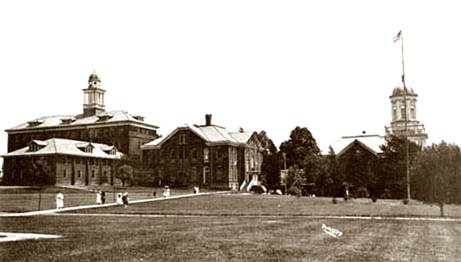|
FEBRUARY 2020
|
|
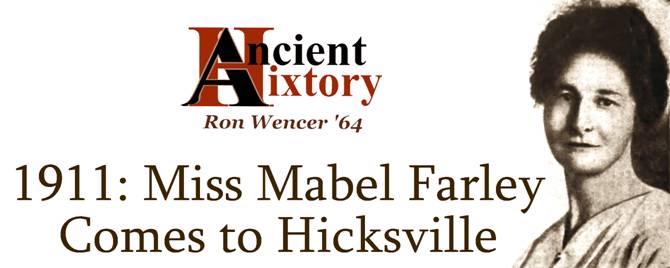
|
|
One April morning, a young woman from the
Susquehanna
Valley
began teaching at the school on
Nicholai Street
. On that day,
neither
Hicksville
nor Mabel Rebecca Farley could have realized that they were
embarking on an enduring and transformative relationship.
This article, which covers Miss Farley's first twenty years in
Hicksville
, is the first installment in a series of Ancient Hixtory
articles about her life and career.
|
|
***
|
|
Background
|
America
was
overwhelmingly rural, and in rural areas, four-year high schools were
rare. Small-town schools
generally taught students only through grade eight, or they offered two
more optional years of instruction.
To earn a four-year diploma, one had to attend a high school in
another, likely larger, town. In
Hicksville, for example, such pupils might go to
Mineola
or Hempstead High to finish their studies.
Of course, most older Americans had never even attended high school.
As late as the 1920s,
Hicksville
's School Board was headed by a man who had left school after the
seventh grade. Ironically,
all the teachers at the village's
Union
School
(see below) had educations superior to his, because to teach, one had to
graduate from a normal school,
the forerunner of a teachers college.
|
In 1853,
New York
State
established a legal structure to make high school education more
readily available, especially in rural areas. A group of small
towns could band together with a town that had a four-year high
school, offering youth in all the towns in this educational
"union" the opportunity to earn high-school diplomas.
For whatever reason, the law-makers named such groups "Union
Free School Districts." Any
authorized feeder school in such districts was called a "
Union
School
."
|
While
she was still a child, Mabel Farley decided to someday become a teacher,
and she never lost sight of that goal.
Around 1900, her public school studies completed, she enrolled at
the normal school in
Bloomsburg
,
Pennsylvania
, about thirty miles from her home in the little town of
White Deer
. She must have been a
dedicated student, for later, at her graduation ceremony at Bloomsburg,
she was praised both for her teaching ability and for her academic
prowess.
Qualified,
and showing much promise, she returned to her home town, and soon began
her first teaching job. She
was still in White Deer several years later, where the 1910 U.S. Census
recorded that both Mabel and her younger sister Lera were public school
teachers. It is easy to
think that her older sister's success had inspired the younger Miss
Farley's choice of career.
Mabel still had the passion for learning that had helped her win
accolades at Bloomsburg. Although
Penn
State
was about seventy miles away, she had begun to study there, working
towards a Bachelors degree.
|
***
|
|
Hicksville
,
Meet Mabel
|
Of all the teachin' joints in all the towns in
all the world, how did Mabel Farley happen to walk into
Hicksville
's?
The simple answer is that she applied to an employment agency for
teachers. The likely reasons
for her choosing
Hicksville
are a bit more complicated.
She was blessed with exceptional gifts, and doubtless she wanted to make
the most of them. How much
opportunity for her own growth lay ahead where she had been teaching?
How quickly could she acquire a Bachelors degree, and then a
Masters, if she were to continue at White Deer?
Evidently, she had gained enough confidence to try teaching
elsewhere - perhaps anywhere, if it was a place where her talents
would be recognized. Her own
continuing education mattered a great deal, and any new teaching job
would have to be reasonably close to a university, at which she could
continue her own studies. She
also would want an opportunity earn her way into more responsible
duties.
Salary would not have been an issue, for she was not one to live
lavishly. Moreover, given
her demonstrated abilities and her experience, she could expect any job
she was offered to provide a decent income.
The opportunity for her to learn and advance would have mattered
more.
|
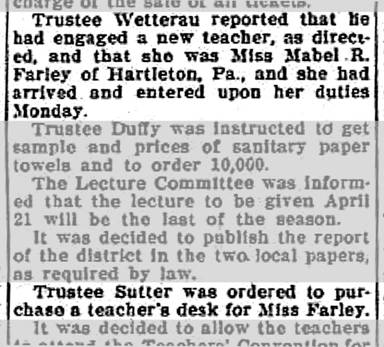
|
|
Huntington
Long-Islander, April 7, 1911
It is interesting to note the responsibilities that went with
being a Trustee on a small-town Board of Education.
|
Newspaper
articles from this era indicate that Long Island teachers often were
"imported" from upstate
New York
or from rural areas in other states, where normal schools tended to be
located.
Hicksville
already had been willing to hire young women from such places.
To have an applicant from one more small town like White Deer
would not have surprised the Board of Education.
Most likely, Mabel's first reaction to the thought of teaching in
Hicksville
was to learn whatever she could about the place.
The agency, which may have placed other teachers there, probably
gave her some basic information about the school and the position.
In addition, it would have told her about Long Island's strong
agricultural economy, Hicksville's ever-expanding Heinz factory, the
convenient new trolley line, and the easy access to Manhattan - via
the LIRR tunnels that had opened just months before.
The tunnels would fit in nicely with her plans.
First, because she could ride a train into Pennsylvania Station,
and then take the subway to, say,
New York
University
. Second, because many town
populations in
Nassau
County
already were growing, as the tunnels had made commuting easier.
Schools in
Nassau
would need more teachers in the future, because they would have more
students to teach. Without
question, being Mabel Farley, she could become a valued part of any of
the schools, including
Hicksville
, and as "her" school grew, she would be considered for advancement.
She must have greatly impressed the members of the Hicksville School
Board, for there was one aspect of her job that was not disclosed in the
article excerpted above. Perhaps
it had not yet been confirmed when the article was written in April, but
by the time the
Union
School
opened the following September, it was known that Miss Farley was more
than a teacher - she was also the
school's Assistant Principal.
That a woman under thirty achieved this status in 1911's
Hicksville
attests to her maturity, character and exceptional abilities.
|
***
|
|
Life
at the
Union
School
|
|
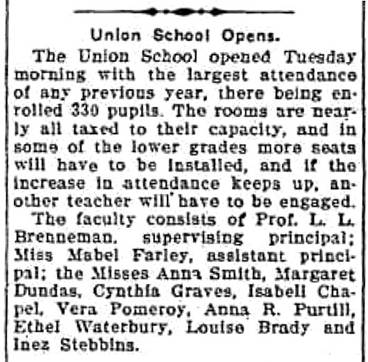
|
|
Huntington
Long-Islander, September 6, 1912
|
As
can be seen in the above list, there was only one male in the faculty
- the Principal. In this
era, this pattern - multiple female worker bees and one King Bee -
was not universal, but it was widespread.
Even worse for career women, it was understood that female
teachers had to remain single, so as to not disrupt schools by taking
maternity absences.
The
Union
School
actually consisted of two sections.
The first was built in 1897; its similarly-sized neighbor to the
west was built in 1909. Only
two years after the school's size was doubled, it again was too small,
due to the village's growth. For
example, classes for the eighth, ninth, and tenth grade had to be held
simultaneously in a single room, with their respective teachers covering
different subjects.
|

|
|
One
of Miss Farley's early Grade 8 classes at
Nicholai Street
Nassau
Daily Review-Star, May 9, 1941
|
The
overcrowding grew worse every year.
To gain classroom space, the School Board tried to eliminate
Kindergarten, but the taxpayers rejected the idea.
Ultimately, Kindergarten was moved off-site, although no truly
suitable alternate location for it was ever found.
Eventually, some senior grades used the "assembly hall"
instead of class rooms; again, the space was unsuitable - and such use
of an auditorium was contrary to State regulations.
Second grade was put on split-sessions, using an innovative
approach that reportedly had no negative impacts.
The two teachers for the grade worked full days.
In the morning session, one of them conducted the class at an
accelerated pace, while in a back corner of the room a small group of
"slower learners" got special attention from the other teacher.
The afternoon session was similar, with the teachers' roles
reversed. It was a trying
time for everyone at the school. Mabel's
position must have been exceptionally demanding, as at times she would
have had to serve as a buffer for her boss.
Staff turnover was unacceptably high, with overcrowding a contributing
cause. For example, in
1912-1913, there were twelve teachers on staff.
As of March, only five of them were willing to commit to
returning to their jobs in September, four were committed to leaving,
and the remaining five might be rehired if they later were willing and
available. The Principal,
who would be the most difficult to replace if he left, likely was
getting tired of dealing with both the School Board and with parents
about problems, especially overcrowding.
He was granted a three-week extension to decide, during which he
probably tried very hard to find another job.
|
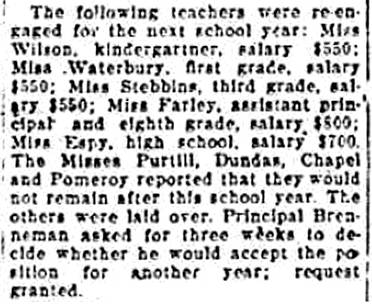
|
|
Huntington
Long-Islander, March 7, 1913
|
Let's
try to put the salary figures above into context.
U.S. Census data indicates that at this time, the national
average income for a male worker was about $680, and women averaged
about half of that. In this
context, the salaries listed above seem excellent - but in the New
York metropolitan area, both salaries and costs were higher than the
national average - a given income did not go as far in Hicksville as
it would, say, in rural Kentucky. One
indication that the teachers' salaries, while good, were not
exceptionally high for the region is that many
Hicksville
teachers lived as boarders in homes or rooming houses.
At first, for example, Mabel Farley boarded in the home of School
Trustee Wetterau. Other
teachers instead banded into small groups, and together shared a rented
accommodation.
With regard to Farley's own educational aspirations, at the time,
tuition for a full-time student at NYU was $150 a year.
Prorating that figure downward for part-time students might still
have left a figure that seemed substantial to a teacher whose annual
income was $800 or less.
The
1915-1916 school year saw a development that probably will surprise many
readers: Lera Farley, mentioned earlier as Mabel's younger sister,
came to
Hicksville
as a teacher.
|
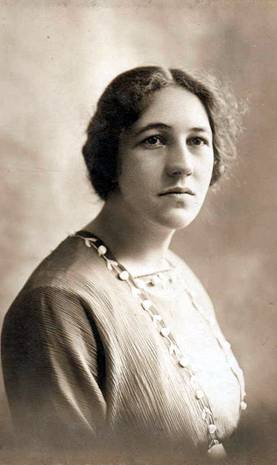
|
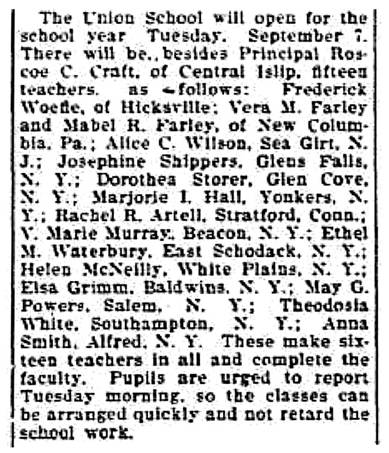
|
|
Lera
Martha Farley
Devlin-Yard Family Tree, Ancestry.com
|
Huntington
Long-Islander, September 3, 1915
Lera's name is mistakenly given as 'Vera'
|
Why
did she come to
Hicksville
to teach? The
Union
School
, as it often did in these years, may have had an unexpected late
vacancy suitable for an experienced teacher.
Or, as this was to be Lera's final year of teaching (i.e., she
would marry in 1916; Mabel would serve as her Maid of Honor), the two
sisters might have thought it would be nice to work together again.
Or perhaps it was simply that the idea of spending some of her
free time in New York appealed to Lera.
Alas,
the overcrowding would continue far too long.
It took more than a decade (and an intervention by the State of
New York) before the people of Hicksville agreed to pay for the
construction of adequate new classroom space.
Until then, the faculty of the Union School - at least those
among them who chose to stay at their jobs - had to improvise as best
they could. Although
Principals would change, Miss Farley would patiently remain the
Assistant Principal for fourteen years.
|
***
|
|
Achievements
for Hicksville,
And Also for Miss Farley
|
Early
on, Mabel was an advocate of the town's creating its own four-year
high school program. Support
grew rapidly, and such a program was introduced in the autumn of 1914.
She would always remain proud of the role she had played in
establishing true high school education in Hicksville.
|
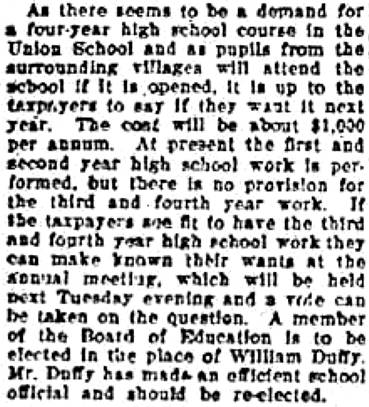
|
|
Huntington
Long-Islander, May 2, 1913
I believe that the cost estimate quoted here - $1,000 per
annum - refers not to the cost per taxpayer,
but instead to the net total increase in the village's school
budget.
|
In
hindsight, it seems odd that the School Board was willing to expand the
number of classes in the building without also making plans to add more
classrooms. As the newspaper
article states, adding the new grades would mean more Hicksville
students in the school, and also adding students from Bethpage and
Farmingdale, which still lacked their own high schools.
The
1920s brought significant changes. New
classroom space finally became a reality, first in 1925 with the opening
of a purpose-built secondary school on Jerusalem Avenue, which
originally housed both Junior and Senior high school classes (the
structure, much expanded over the years, now is the home of Hicksville
Middle School). You can read
about how it came to be built in the May 2018 Ancient
Hixtory, which is available online by clicking this link: 1805/Wencer.htm
In
1927, even more space was created by the construction of a new primary
school on East Street.
|
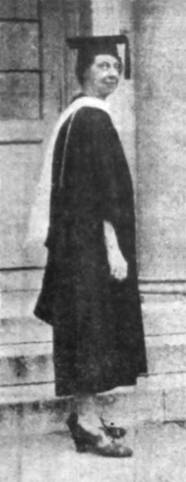
|
The decade was also a period of great personal achievement for Mabel
Farley.
At long last, she completed her undergraduate work, and was
awarded a Bachelor of Science degree by New York University in
1923.
Two years later, with the opening of the new high school, she
became Hicksville's first female Principal.
It is probably relevant that George Duke, elected
President of the Board of Education on the basis of his
intention to finally end high faculty turnover in Hicksville,
sanctioned her appointment.
She had a knack for dealing with people.
In 1929, Miss Farley attained another milestone which she had
long sought, earning a Masters degree, again at NYU.
|
|
Nassau
Daily Review-Star
May 9, 1941
|
|
|
|
|
Despite her having accomplished so
many of her lifetime goals by 46, she did not lose her determination to
excel - nor did she let the school system sit on its heels.
Speaking some years later at an event that marked the
twenty-fifth anniversary of Hicksville's four-year high school
program, in part she said:
We cannot be content with what we
have accomplished. We must
dedicate ourselves to a speedy beginning for another twenty-five years
of progress. We must be
united in promoting hopefulness in our youth.
We must make a concerted effort to uncover new opportunities for
our graduates... [who] must make the necessary adjustments to the
situations in which they find themselves when leaving school.
|
***
|
|
End
of this Installment
|
|

|
Note that the picture of Miss Farley used at the beginning of this
article appeared in the Nassau
Daily Review-Star on May 9, 1941.
Reportedly, it was taken in Hicksville shortly after she first
arrived. Like all the
photographs used here, it has been digitally altered by the author.
|

